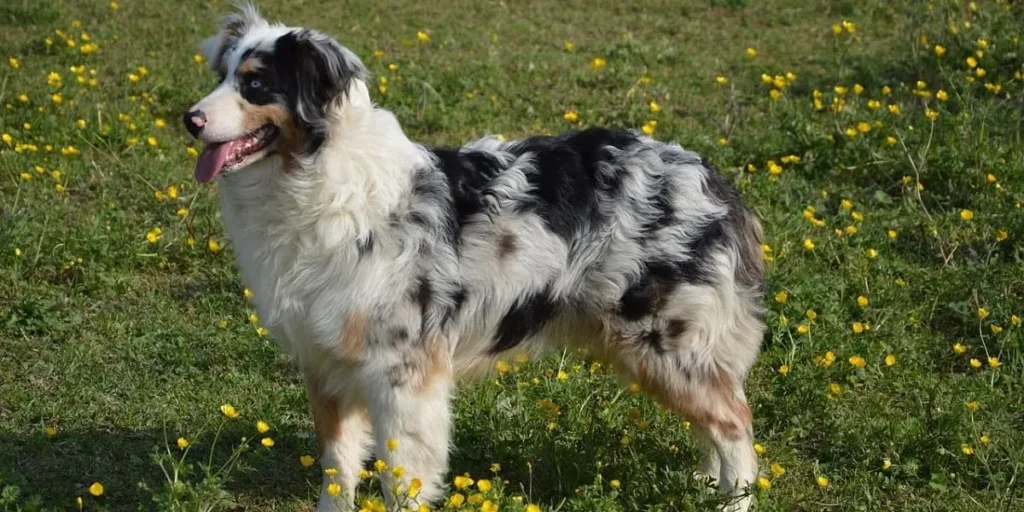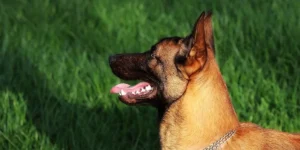Table of contents
- Characteristics of the Breed
- History of the Breed
- Physical Characteristics
- Temperament and Character
- Behavior with Others
- Training
- Living Conditions
- Health
- Life Expectancy
- Grooming and Hygiene
- Price and Budget
- Name Ideas for an Australian Shepherd
- Diet
- Physical Activity
- Famous Australian Shepherds
- Competitions
- FCI Information
Characteristics of the Breed
| Australian Shepherd: Characteristics | ||
|---|---|---|
| Origin | United States | |
| Size | Medium | |
| Coat type | Medium | |
| Average lifespan | 12–15 years | |
| Hypoallergenic | No | |
| Australian Shepherd: Measurements | ||
| Female | Male | |
| Weight | 16–23 kg | 20–29 kg |
| Height | 46–53 cm | 51–58 cm |
Affectionate yet strong-willed, the Australian Shepherd (Aussie) was built for activity and work. Combining keen intelligence with athleticism, this medium-size dog adapts well to family life and varied environments – provided it stays mentally and physically engaged. The breed has seen a surge in popularity in recent years.
History of the Breed
Despite its name, the Australian Shepherd did not originate in Australia. The breed was developed in the United States by farmers in the early 1900s to gather livestock. Many theories exist, but a commonly cited origin traces to Basque shepherd dogs that migrated to North America and then Australia before arriving in the U.S. In the 19th century, pastoral workers from the Pyrenees moved toward regions where wool production was booming; their dogs – similar to modern Aussies – proved valuable for flock management. After World War II, the Aussie’s popularity grew thanks to its versatility and intelligence on ranches. Today, while it still assists shepherds and farmers, it is also a beloved family companion.
Physical Characteristics
- Coat: Straight or slightly wavy, weather-resistant, and of medium length with a double coat (guard hair over undercoat); shorter on the head and ears; males may show a light ruff.
- Colors: Blue merle, red merle, red, or black, with or without white markings or tan points.
- Head: Flat or slightly domed skull, well proportioned; muzzle length roughly equal to skull width.
- Ears: Triangular, set high, naturally dropped.
- Eyes: Almond-shaped – amber, brown, or blue, sometimes mixed or mottled – showing intelligence, liveliness, and vigilance.
- Body: Slightly longer than tall; well-sprung ribs, slightly sloping croup, deep chest.
- Tail: Straight and not to exceed 10 cm (≈4 in).
Temperament and Character
The Australian Shepherd is built for action without being quarrelsome. Playful and curious by nature, it can instinctively drive or guard a herd. Hardy and resilient, it adapts well to family life as long as it has outlets for its energy. Renowned for loyalty, energy, and a balanced temperament, the Aussie may be somewhat reserved with unfamiliar people. At work, it displays versatility, enthusiasm, agility, and sharp perception.
Behavior with Others
| Lives with children | Yes, with supervision and training |
| Sociable with other animals | Yes, with early socialization |
| Enjoys strangers | Variable; often reserved initially |
This action-oriented breed is not naturally combative. It endures long days and adapts well to family routines as long as activities are provided. Its remarkable intelligence helps it adjust to varied tasks.
Training
Training can begin as early as two months to build manners and channel energy. Education must be firm but never harsh; the Aussie learns best through rewards and encouragement. Given its drive and strong will, thorough socialization is essential. Pairing training with canine sports (agility, canicross, etc.) supports fulfillment.
Living Conditions
| Apartment-friendly | Not ideal; possible only with ample daily exercise |
| Good for first-time owners | Yes, if active and committed to training |
| Likes warm weather | Yes |
| Likes cold weather | Yes; provide shelter in harsh conditions |
The Australian Shepherd prefers homes with yards to express its athletic temperament. It craves companionship and needs as much affection as action; frequent outings and avoiding long periods alone are important.
Health
| Robustness | Moderate to high |
| Weight gain tendency | Variable; monitor diet and activity |
The breed is predisposed to certain hereditary eye conditions (often grouped under MOHC – Canine Hereditary Eye Diseases). Yearly screening is recommended for progressive retinal atrophy (PRA), Collie Eye Anomaly (CEA), and juvenile cataracts. Hip and elbow dysplasia, as well as epilepsy, may occur; skin conditions have also been reported. Deworming three times per year is commonly advised. Caution: ivermectin (present in some dewormers) can be toxic for Australian Shepherds.
- Hypoallergenic breed: No
- Litter size: 3–10 puppies (average 7)
Health Concerns Overview
| Major concerns | Collie Eye Anomaly (CEA); Cataract; Epilepsy |
| Minor concerns | Pelger–Huët anomaly; Iris coloboma; Hip dysplasia |
| Occasional concerns | Allergies; Progressive retinal atrophy (PRA); Distichiasis; von Willebrand disease; Patent ductus arteriosus (PDA); Lumbosacral syndrome |
| Suggested tests | Hips; Eyes |
Life Expectancy
| Minimum | 12 years |
| Maximum | 15 years |
Grooming and Hygiene
| Ease of grooming | Moderate |
| Maintenance cost | Moderate |
| Shedding level | High during biannual molts |
| Drooling level | Low |
| Ease to groom | Moderate; regular brushing required |
Provide deworming every four months as advised by your veterinarian and keep vaccinations up to date. Trim nails regularly to avoid splitting; clean ears frequently to prevent wax build-up; and brush teeth to slow tartar. The Aussie sheds twice per year – often heavily – so routine brushing is essential. Its largely self-cleaning coat usually needs only one bath per year; use a dog-specific shampoo to prevent skin and coat dryness. During heavy shedding, frequent brushing prevents mats and removes dead hair. A soft-pin slicker brush (metal or plastic) helps dislodge plant debris after walks.
Price and Budget
| Purchase price | €700–€1500 (≈$750–$1,600) |
| Annual upkeep | €1300–€1400 (≈$1,400–$1,500) |
Name Ideas for an Australian Shepherd
- Male: Agile, Banco, Coyote, Dali, Eiko, Funky, Joker, Lewis, Nougat, Samy
- Female: Abby, Bianca, Canelle, Diana, Galina, Jodie, Lexie, Macha, Pandora, Shannon
Diet
Provide a balanced diet tailored to activity level. High-quality kibble is commonly preferred over home-prepared diets because complete formulas supply essential nutrients when well chosen. Homemade feeding can cause deficiencies or excesses unless expertly formulated. Daily amounts vary by metabolism and exercise; as a guideline, 280–320 g per day (split into two meals) is often cited for an adult Australian Shepherd.
Physical Activity
The Australian Shepherd needs space and daily exercise. A single daily walk can suffice if it lasts at least 30 minutes. Canine sports such as agility, canicross, frisbee, and obedience games are recommended for enrichment. Puppies should avoid excessive jumping and running on hard surfaces to protect joint development.
Famous Australian Shepherds
Huck: Appearing alongside the cast of the family film “Marmaduke” (August 2010). Huck, a blue merle female, played Maizy, Marmaduke’s best friend. Three additional Aussies served as doubles. Trainer Cristie Miele taught behaviors such as interacting with Marmaduke, vocalizing, and opening a garage door.
Competitions
Classifications & Standards: AKC (American Kennel Club); ANKC (Australian National Kennel Council); CKC (Canadian Kennel Club); FCI (Fédération Cynologique Internationale); KC (The Kennel Club); NZKC (New Zealand Kennel Club); UKC (United Kennel Club).
FCI Information
| FCI Number | 342 |
| FCI Group | Group 1: Sheepdogs and Cattle Dogs (except Swiss Cattle Dogs) |
| Recognized by FCI | Since 1996 |


